Understanding Basketball Training Programs
Basketball training programs are essential for players seeking to improve their skills, enhance their performance, and reach their full potential on the court. As the competitive nature of basketball continues to grow, players of all ages and skill levels recognize the benefits of structured training regimen. However, with numerous options available, identifying the best basketball training programs can be a daunting task. This comprehensive guide will delve into the intricacies of basketball training programs, providing insights into what makes them effective and how to select the right one.
What Makes a Basketball Training Program Effective?
An effective basketball training program should be multifaceted, targeting various aspects of player development. Key characteristics include a well-structured curriculum, experienced coaching, individual assessments, and a progression plan tailored to the player’s skill level. Here are some fundamental aspects to consider:
- Curriculum Design: A program should cover technical skills (shooting, ball-handling, defense), tactical understanding (game strategy, positioning), strength and conditioning (physical fitness, agility), and mental preparation (focus, resilience).
- Coach Expertise: Instructors should have relevant experience, preferably both playing and coaching at competitive levels. A knowledgeable coach is vital for delivering effective feedback and personalized training adjustments.
- Player-Centric Approach: Every athlete is unique. Effective training programs assess individual strengths and weaknesses and adjust activities accordingly to maximize growth.
- Progress Tracking: Regular evaluations and feedback loops enable players to measure their progress and stay motivated. Effective programs should implement performance metrics and adjust training intensities based on these evaluations.
Common Goals of Basketball Training Programs
The objectives behind basketball training programs can vary widely based on the player’s age, experience, and aspirations. However, common goals include:
- Skill Development: Beyond mastering basic skills, players aim to develop specialized techniques that can set them apart, such as advanced shooting forms or unique dribbling styles.
- Game Insight: A solid understanding of the game is fundamental. Training aims to enhance a player’s decision-making skills during high-pressure situations, enabling them to perform effectively in games.
- Athletic Conditioning: Strength, agility, speed, and endurance increase players’ overall effectiveness. Conditioning programs are often intertwined with skill drills to promote on-court performance.
- Mental Toughness: Basketball is as much a mental game as it is a physical one. Training focuses on building athletes’ concentration, confidence, and composure under pressure.
Different Types of Basketball Training Approaches
When evaluating basketball training programs, one can find various approaches tailored to the needs of players and teams. Here are some prevalent training styles:
- Skill-Specific Clinics: These short-term programs focus intensely on developing particular skills, such as shooting, defense, or basketball IQ. Ideal for experienced players looking to refine their expertise.
- Year-Round Programs: Comprehensive programs offered by training facilities or specialized academies provide year-round training, ensuring players maintain their development with consistent practice sessions.
- Team Camps: Camps aimed at teams emphasize teamwork, strategy development, and in-game dynamics. Coaches often utilize these programs to prepare players for competitive seasons.
- Online Training: Virtual training platforms have gained popularity, allowing players to access workouts, drills, and coaching tips from their homes. This approach supports self-directed learning and flexibility.
Evaluating the Best Basketball Training Programs
Criteria for Selection
When assessing various training programs, consider the following criteria:
- Reputation: Research the program’s standing in the basketball community. Look for program endorsements from former players or positive reviews from parents and athletes.
- Curriculum: Examine the structure of the program. Does it provide a comprehensive approach covering skills, conditioning, and mental training?
- Customization: Ensure the program offers personalized training regimens tailored to individual players’ strengths and weaknesses.
- Location and Accessibility: For in-person programs, consider travel time and commitment required. Online options should be flexible and user-friendly.
Player Testimonials and Reviews
Accumulating feedback from past participants can provide invaluable insights into a program’s efficacy. Testimonials and reviews often highlight key aspects, including:
- Coaching effectiveness and player development
- Program structure and organization
- Overall experience and results achieved
- Player satisfaction and areas for improvement
Comparing Online vs. In-Person Programs
As online training options broaden, players have a choice between traditional in-person coaching and virtual alternatives. Both methods have unique advantages:
- In-Person Programs: These provide hands-on coaching, allowing immediate feedback and adjustments during practice. Players benefit from peer interactions and competitive environments.
- Online Programs: These offer flexibility and accessibility, accommodating various schedules and locations. Athletes can tailor their training around personal commitments while still receiving quality instruction.
Key Elements of Successful Training Regimens
Skill Development Drills
Skill development is at the core of any basketball training program. Drills should encompass:
- Shooting Drills: Techniques such as form shooting, catch-and-shoot, off-the-dribble shots, and game-situation shooting enhance a player’s scoring ability.
- Dribbling Drills: Cones, defenders, and obstacles challenge players to improve their ball-handling while maintaining control and agility.
- Defensive Drills: Practicing footwork, positioning, and 1-on-1 scenarios fosters defensive skills that are crucial in competitive play.
- Passing Drills: Team drills encourage communication and tactical passing under pressure, enhancing on-court teamwork.
Strength and Conditioning Techniques
Physical fitness is an integral part of succeeding in basketball. Conditioning might include:
- Weight Training: Building muscle strength enhances players’ abilities to withstand physical challenges on the court.
- Agility Drills: Ladder workouts, shuttle runs, and plyometrics help improve speed and quickness, which are crucial in basketball.
- Endurance Training: Routines focusing on stamina, such as jogging and interval training, extend players’ performance capabilities in games.
Mental Preparation Strategies
Mental strength often determines success in high-pressure situations. Training should incorporate:
- Visualization Techniques: Players can practice successful plays in their minds, which can improve performance during actual games.
- Goal Setting: Establishing short and long-term goals keeps players motivated and focused on their development.
- Stress Management Exercises: Techniques for relaxation and focus, such as breathing exercises, can aid players in managing game-day nerves.
Adapting Training Programs for Different Skill Levels
Training programs should be adaptable to accommodate players’ varying skill levels. By customizing content and intensity, coaches can ensure a more effective training experience for all athletes.
Beginner Programs: Laying the Foundation
Beginner programs focus on fundamental skills and concepts:
- Basic Skill Drills: Introduce core techniques such as dribbling, passing, shooting, and defense to establish a foundational understanding of the game.
- Game Introduction: Teach basic rules, ball movement, spacing, and positioning in a non-competitive environment.
- Fun Activities: Engage players in creative drills that encourage teamwork and enjoyment of the sport.
Intermediate Programs: Building on Basics
As players gain experience, intermediate programs should enhance existing skills:
- Advanced Drills: Incorporate more challenging exercises that involve game-like situations, promoting the application of skills under pressure.
- Strategy Development: Teach players how to interpret plays and adapt strategies for game scenarios.
Advanced Programs: Fine-Tuning Performance
Advanced programs cater to competitive athletes working to refine their elite-level skills:
- Position-Specific Training: Focus on skills and techniques relevant to specific positions, whether point guard, shooter, or center.
- Game Simulation: Utilize scrimmages and drills that mimic game conditions to enhance decision-making and tactical awareness.
- Performance Analysis: Consult analytics and performance metrics to pinpoint areas for further refinement, thus ensuring continuous growth.
Maximizing Results from Basketball Training Programs
Once players select a training program, maximizing results becomes paramount. This involves a commitment to consistent practice, effective tracking of performance metrics, and incorporating feedback for continuous improvement.
The Importance of Consistency in Training
Consistency is critical in achieving development goals. Here are strategies to maintain a disciplined training schedule:
- Regular Attendance: Set specific days and times for training to establish routine and commitment.
- Incremental Progress: Celebrate small milestones and accomplishments, keeping motivation high while gradually increasing the difficulty of drills.
- Balanced Training: Incorporate various aspects of training (skill work, conditioning, and mental preparation) into each session for holistic development.
Utilizing Performance Metrics for Improvement
Using performance metrics is crucial in gauging progress. Consider the following:
- Self-Evaluations: Players should reflect on their performances after practices and games to identify strengths and areas needing improvement.
- Coach Feedback: Seek detailed feedback from trainers or coaches regarding specific skills and overall progress.
- Game Statistics: Tracking personal stats, including points, assists, rebounds, and turnovers, helps in assessing areas for development.
Incorporating Feedback for Continuous Growth
Feedback is vital for improvement. Players should actively solicit and implement suggestions from coaches and peers:
- Mentorship: Seek experienced players or coaches as mentors who can provide guidance and share valuable experiences.
- Open Communication: Maintain a dialogue with coaches and teammates, expressing areas of concern and discussing improvement strategies.
- Reassess and Adapt: Regularly review training goals and adjust programs to ensure they align with evolving player needs and capabilities.



